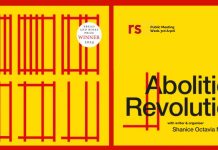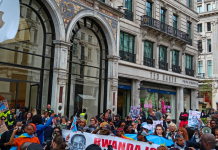The post war youth subculture that became the subject of a moral panic reflected the changing economic circumstances and contradictory politics of the period, writes Mitch Mitchell.
In the late 1940s, after the end of WWII, the fashion industry in Britain was in the doldrums. This was partly due to wartime rationing, which made obtaining certain kinds of materials difficult, and partly because many of the people who would have been customers were either serving in the forces abroad, or had been killed.
In an attempt to kick-start the business, the men’s tailors of Jermyn Street and the West End devised a style based on the turn of the century, Edwardian clothing. They were hoping to sell to the young officer class who were being demobbed from the various services.
Unfortunately for the tailors, the look didn’t catch on with these people and they were stuck with piles of unsold clothing. In order to get something back on their investment, they sold job lots to the menswear shops of East and South London at very cheap prices.
These shops put them on display in their windows and the local working class youth took a liking. Around about 1951, the ‘Teddy Boy’ look began to emerge. This coincided with young people generally having more disposable income and a desire to not look like cut-down versions of their fathers.
They adapted the look with the addition of bootlace ties, à la Mississippi gamblers, luminous pink or green socks and crepe soled shoes, known as ‘Brothel Creepers’. People had seen pictures from America of young men wearing what were known as ‘Zoot Suits’. As in those days, everything American was cool, they tried to emulate. The main differences between Teds’ outfits and the Zoot suits were that in Britain, the drape jackets were worn with skintight jeans or trousers, known as ‘drainpipes’, and that many American kids wore large hats.
Also, because rationing was still in force until 1954, the material used whatever the tailor could get hold of. This meant that plain colours were often employed or even Harris Tweed. Very bright drapes were unusual and more common with the second generation of Teds from the ’60s. One exception to this was the sky blue jackets worn by the Elephant and Castle gang.
Back then, gangs were identified by the area they lived in. Fights between gangs were fairly common and the Elephant mob would fight with Deptford who in turn would fight with Rotherhithe, and they would take on Bermondsey.
Weapons of choice were bicycle chains, flick knives (outlawed in 1957), cut-throat razors and knuckle dusters. These knuckle dusters were often just coins wrapped in a handkerchief which was the wound around the fist.
In 1953, a highly publicised court case hit the headlines, involving Christopher Craig, aged 16 years old, who had shot a policeman in Croydon. His accomplice, Derek Bentley, was 18, but had a mental age of 8, and was hanged for the offence despite being in police custody when Craig fired. Craig, at 16, was too young to hang.
This led to much hand-wringing by newspapers such as The Daily Mail, The Daily Graphic (later becoming The Sketch), The Daily Express, and others, all calling for ‘something to be done to stop this growing menace on our streets’.
Although Teddy Boys are usually associated with rock ‘n’ roll music, the earlier Teds listened to Frankie Laine, Guy Mitchell and Johnny Ray. The first Ted oriented record to hit the charts was called ‘The Creep’, which was a jazzy big-band record by Ken MacIntosh and his Orchestra. The title is probably what sold it, because of the brothel creeper shoes.
The first ‘Rock ‘n’ Roll Riot’ occurred outside the Astoria cinema in the Old Kent Road (the site is now a discount warehouse, albeit the cinema was long demolished). The audience had been to see the film Blackboard Jungle, starring Glenn Ford and Sidney Poitier. Although having absolutely nothing to do with the story, the record Rock Around The Clock by Bill Haley and His Comets was played over the credits at the beginning and end of the movie.
 Inspired by the music, the crowd left the cinema, singing the song and dancing in the Old Kent Road and stopped the traffic – a heinous crime in London. Tabloids of the day like The Mirror and The Sketch (this was before The Sun) got hold of the story and so the ‘rock ‘n’ roll riot’ was born. In 1956, a knock-off movie entitled Rock Around The Clock featuring Haley, The Platters, Freddy Bell & the Bellboys and others was released, and the idea of jiving to the music in the cinema caught on around the country.
Inspired by the music, the crowd left the cinema, singing the song and dancing in the Old Kent Road and stopped the traffic – a heinous crime in London. Tabloids of the day like The Mirror and The Sketch (this was before The Sun) got hold of the story and so the ‘rock ‘n’ roll riot’ was born. In 1956, a knock-off movie entitled Rock Around The Clock featuring Haley, The Platters, Freddy Bell & the Bellboys and others was released, and the idea of jiving to the music in the cinema caught on around the country.
The following year, the Tory government, aware that a General Election was approaching, took what they deemed tough action against these ‘teenage tearaways’. They banned the possession of flick knives and also banned the importation of American ‘Horror Comics’ such as Tales From The Crypt. These comics had become part of moral panic, and the focus of campaigns by Church leaders and others.
In the 1950s, young men of 18 were required to do at least two years of military service (the ‘call up’). This usually involved joining the Army, as the Navy and RAF required new recruits to sign on for longer than two years. In effect, this began to make the original Teds disappear, and younger kids coming up to around 16 were looking for something new.
So, in 1957, Teddy Boys in London began to be seen less and less. The fashion chains tried a new variation which was called ‘Viccy Boys’, based on Victorian styles, but this never really caught on and by 1958, the sharp Italian suit became a thing. These were often mohair with short, box jackets (known as ‘bum freezers’) reasonably tight trousers, but not ‘drainpipes’, and long pointed shoes or boots, nicknamed winkle pickers.
It has to be remembered that, by and large, Teddy Boys were a working class phenomenon. Mostly they came from the council estates, post war prefabs, and the Peabody and Guinness Trust estates.
There was a post war employment boom and most of the teds had jobs. Unemployment was extremely low throughout the ’50s and ’60s (below 400,000 for most of the period). This meant that young people had a higher disposable income than their parents’ generation.
This was also a time of significant immigration to the ‘mother country’ from various parts of the Empire and Commonwealth, with the largest numbers coming from the Caribbean. Some trade unions were very bad at how they dealt with this. The Transport and General Workers Union, for example, allowed shop stewards to call out bus garages if they employed black workers (usually bus conductors – they weren’t thought capable of driving). The old saw ‘British Jobs for British Workers’, first used regularly by Oswald Mosley pre-war, was frequently trotted out.
Far-right tabloids like The Daily Graphic (later Daily Sketch) and populist broadsheets like the Daily Express and Sunday Express and Daily Mail poured vitriol onto the situation.The only papers in the mainstream to be any way sympathetic to the immigrants were The Manchester Guardian (renamed The Guardian in 1959), News Chronicle and The Observer. Ironically, when Harold MacMillan became Prime Minister in 1957, his Minister for Health who actively recruited in the West Indies, was none other than Enoch ‘Rivers of Blood’ Powell.
All of this had an effect on the wider population, and of course teenagers (as they had become known) were no exception. Undoubtedly, some of those labelled Teddy Boys were racist and took part in attacks, but equally, many were not. Teds got their worst press in 1958 at the time of the Notting Hill ‘race riots’. Lazy journalists used the tag ‘Teddy Boy’ to describe any young working class person involved in a fracas. In any case, the fashion was already beginning to die out in London by 1958, so, whilst some could genuinely be labelled as such, it was not a Teddy Boy led fight.
A couple of years later, Mosley tried to arrange a tour of the UK to spread his poisonous message and it became a ‘thing’ to break up his meetings. Many of those involved in breaking his meetings would have been painted as Teds a couple of years earlier. Areas vied with each other to see who could bust Mosley the quickest. As far as I’m aware, Croydon held the record. His meeting at Derby Road Baths in the town lasted all of 90 seconds!
The Teddy Boy look continued outside of London well into the 1960s, especially in Wales. In London, people either wore the Italian suits, or black leather jackets and jeans. They often kept a drape for going out to clubs as many would not let anyone in leathers inside.
In the late ’60s, there was a second generation who wore the clothes in bright colours and discovered ‘Rockabilly’, a term almost never heard of in Britain in the ’50s. Then again in the ’70s as a reaction to punk, another generation of Teds appeared. They were frequently referred to by the older generation as ‘plastics’.
In between times, other youth groups briefly flourished, mods, rockers, hippies, Hell’s Angel style bikers, skinheads, etc., but the Teddy Boys could reasonably lay claim to having been the first youth ‘cult’.
Teds were no angels, that is true, and the gang fighting could be nasty at times, but they certainly were not as bad as the media painted them and many went through that period of their development without any scars!



















[…] helped rocket the artist to international fame. The series eloquently embodies the emergent 1950s British Pop culture as they depict post-war music-mad teens in their Edwardian frock coats dancing with arms in the […]
[…] Teddy Boys a subculture of youth in the 1950s that was known for their sharp, tailored suits. They often wore suits with drape cuts, skinny ties, and loafers, and they often had slicked-back hair. […]
Hello, I write from Spain. We make a small fanzine for mobile phones, ” El Sueño”. The content is politics and culture from a leftist perspective.
I would love to be able to reproduce this article in our publication. Of course putting the authorship and provenance.
thank you very much in any case
Salud!
Angel
Hi, Spanish comrades – yes, no problem. Good luck with the fanzine.
Colin Wilson, rs21 website editor
Thanks comrade Colin!!!!
Salud!!!! 🙂
[…] self-described Teddy Boy, Lennon wore the Edwardian-era style menswear, complete with drainpipe trousers and drape jackets, […]
[…] self-described Teddy Boy, Lennon wore the Edwardian-era style menswear, complete with drainpipe trousers and drape jackets, […]
[…] August 1958, members of the Teddy Boys (a white nationalist youth group) witnessed an argument between a mixed-race couple: the Swedish […]
You fail to mention that the moral panic against horror comics was supported and encouraged by the Communist Party, just as later it was involved in the campaign of denouncing Bob Dylan’s electrification and perceived sellout of folk music